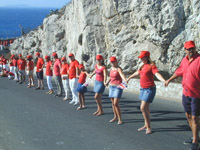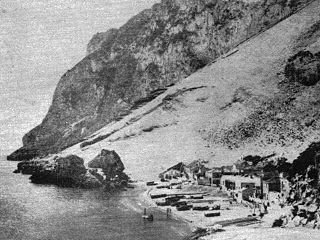
Demographic features of the population of Gibraltar include ethnicity, education level, health of the populace, economic status, religious affiliations and other aspects.

Malta has been inhabited since 5900 BC. The first inhabitants were farmers; their agricultural methods degraded the soil until the islands became uninhabitable. The islands were repopulated around 3850 BC by a civilization that at its peak built the Megalithic Temples, which today are among the oldest surviving buildings in the world. Their civilization collapsed in around 2350 BC; the islands were repopulated by Bronze Age warriors soon afterwards.

The culture of Gibraltar reflects Gibraltarians' diverse origins. While there are Spanish and British influences, a result of the territory's status as a British overseas territory and its proximity to Spain, the ethnic origins of most Gibraltarians are a mix of Andalusian Spaniards, Genoese, Maltese, Portuguese and British. The main religion is Christianity, the majority group being the Roman Catholic Church, then the Church of England. There is a long established Sephardic Jewish community, a number of Hindu Indians and a Moroccan Muslim population. Gibraltarians of Genoese origin came to The Rock in the 18th century, with the Maltese and Portuguese following in the 19th century, coming to work and trade in the British military base. Spanish Andalusian origins are the result of generations of intermarriage with inhabitants of surrounding towns.

Gibraltar is a British Overseas Territory and city located at the southern tip of the Iberian Peninsula. It has an area of 6.7 km2 (2.6 sq mi) and is bordered to the north by Spain. The landscape is dominated by the Rock of Gibraltar, at the foot of which is a densely populated town area, home to some 32,688 people, primarily Gibraltarians.

The sole official language of Gibraltar, a British overseas territory, is English, which is used by the Government and in schools. The eponymous Gibraltarian English accent is spoken in the territory.

The military history of Gibraltar during World War II exemplifies Gibraltar's position as a British fortress since the early 18th century and as a vital factor in British military strategy, both as a foothold on the continent of Europe, and as a bastion of British sea power. During World War II, Gibraltar served a vital role in both the Atlantic Theatre and the Mediterranean Theatre, controlling virtually all naval traffic into and out of the Mediterranean Sea from the Atlantic Ocean.

HMSOlympus was an Odin-class submarine, a class originally designed for the Royal Australian Navy to cope with long distance patrolling in Pacific waters. Olympus was built to the same design for the Royal Navy. She served from 1931 to 1939 on the China Station and 1939-1940 out of Colombo. In 1940 she went to the Mediterranean. She was sunk by a mine off Malta in May 1942 killing 89 crew. 9 survivors: Herbert Rawlings,

Gibraltarians are an ethnic group native to Gibraltar, a British overseas territory located near the southernmost tip of the Iberian Peninsula at the entrance to the Mediterranean Sea.

The Shrine of Our Lady of Europe is a Roman Catholic parish church and national shrine of Gibraltar located at Europa Point. The church is dedicated to Our Lady of Europe, the Catholic patroness of Gibraltar.

Genoese Gibraltarians have existed in Gibraltar since the 16th century and later became an important part of the population. It is an ethnic community made up of descendants of Genoese and Ligurians who emigrated to Gibraltar during the Italian diaspora. The population of Gibraltar with Genoese surnames is around 20% of the total.

Our Lady of Europe is a title given to the Blessed Virgin Mary patroness of Gibraltar and protectress of Europe. The entire European continent was consecrated under the protection of Our Lady of Europe in the early 14th century from the Shrine in Gibraltar where devotion continues to this day, over 700 years on.

John Baptist Scandella STD was a Gibraltarian Roman Catholic priest of Genoese descent. He was Vicar Apostolic of the Diocese of Gibraltar between 1857 and 1880. He spoke fluent English and his native Spanish. Scandella is mainly remembered in Gibraltar for seeing the return of the statue of Our Lady of Europe to Gibraltar from Algeciras in Spain and for his efforts to improve education in the territory.

The history of Gibraltar, a small peninsula on the southern Iberian coast near the entrance of the Mediterranean Sea, spans over 2,900 years. The peninsula has evolved from a place of reverence in ancient times into "one of the most densely fortified and fought-over places in Europe", as one historian has put it. Gibraltar's location has given it an outsized significance in the history of Europe and its fortified town, established in the Middle Ages, has hosted garrisons that sustained numerous sieges and battles over the centuries.

The Crown Colony of the Island of Malta and its Dependencies was the British colony in the Maltese islands, today the modern Republic of Malta. It was established when the Malta Protectorate was transformed into a British Crown colony in 1813, and this was confirmed by the Treaty of Paris in 1814.

Malta Dockyard was an important naval base in the Grand Harbour in Malta in the Mediterranean Sea. The infrastructure which is still in operation is now operated by Palumbo Shipyards.
Immigration to Malta has increased significantly over the past decade. In 2011, immigration contributed to 4.9% of the total population of the Maltese islands in 2011, i.e. 20,289 persons of non-Maltese citizenship, of whom 643 were born in Malta. In 2011, most of migrants in Malta were EU citizens, predominantly from the United Kingdom.

Emigration from Malta was an important demographic phenomenon throughout the nineteenth and twentieth centuries, leading to the creation of large Maltese communities in English-speaking countries abroad.
William Scamp was an English architect and engineer. After working on the reconstruction of Windsor Castle to designs of Sir Jeffry Wyatville, he was employed by the Admiralty from 1838 to his retirement in 1867. Throughout his career of almost three decades, Scamp designed naval facilities in Britain, Malta, Gibraltar and Bermuda.

The Corfiot Maltese are a population from the Greek island of Corfu (Kerkyra) with ethnic and religious ties to the islands of Malta. A large community of descendants of Maltese is still present in Corfu. In the case of the Maltese Corfiot, who lost knowledge of the Maltese language in favour of Greek in the first half of the 20th century, religious confession remained the strongest identity marker. Maltese Corfiots today make up 2/3 of the local Catholic community.



















